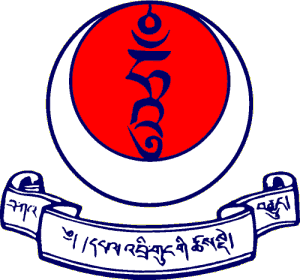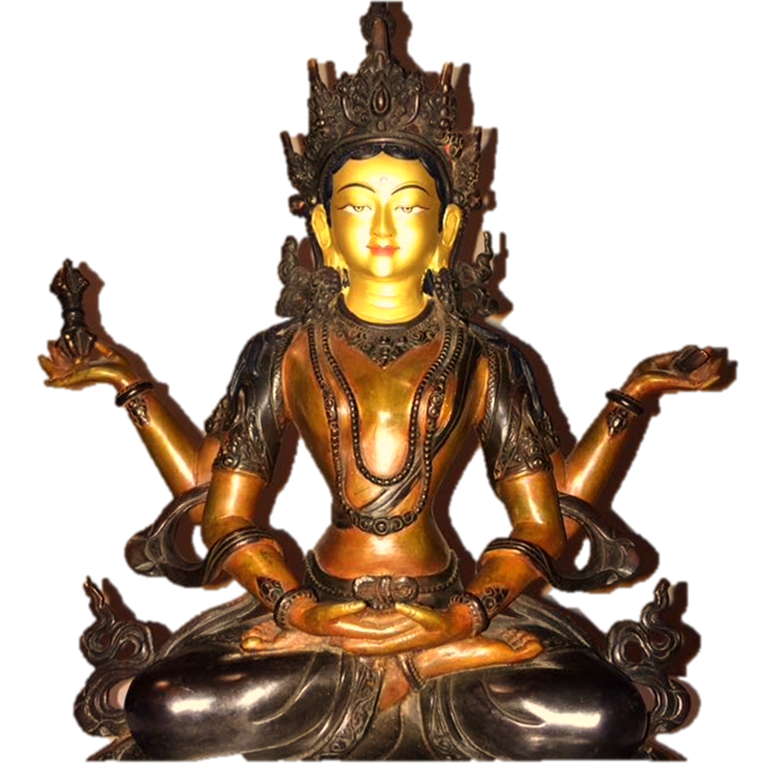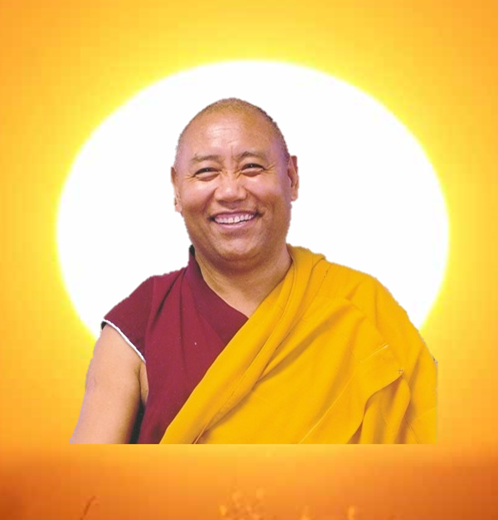| HOME |
 |
Most Venerable Khenchen Konchog Gyaltshen Rinpoche
Public Talk, Heart Sutra and Gong Chik Teaching
August 30 - September 3, 2017 Stockholm, Sweden
This program is dedicated to the commemoration of Lord Jigten Sumgön's 800th Maha Parinirvana.
Download Program
Download Poster for Public Talk
TOP OF LIST
Teaching Program
Public Talk: The Source of Genuine Happiness
Time: August 30 (Wednesday), kl. 18.30 - 20.00
Venue: Folkuniversitetet, Kungstensgatan 45, Stockholm, T- Rådmansgatan
(next to Observatorielunden, between Drottninggatan and Holländargatan)
Free of charge (donation welcome). No registration is required.
Heart Sutra
Time: August 31 - September 1 (Thursday - Friday), kl. 18.30 - 20.30
Venue: Ratnashri Meditation Center, Friggavägen 11, Lidingö (direction)
Fee: 100 kr per evening.
Text: text will be provided.
Heart Sutra or The Bhagavati, Essence of Transcendent Knowledge provides such a powerful antidote to dispel our ignorance (not knowing things as they are) which is the root cause of sufferings in samsara. Great bodhisattva Avalokiteshvara under the blessings of the Buddha explained how to train ourselves in order to actualize the practice of Profound Transcendent Wisdom (realization of absolute emptiness). The pillars of this precious Mahayana sutra include the five skandas, six ayatanas, eighteen dhatus, twelve nidanas (12 links of interdependent origination), Four Noble Truths and the stages of practice such as bodhicitta, Six Paramitas, Five Paths, Ten Bhumis and Perfect Buddhahood. Rinpoche will kindly expound this profound Mahayana sutra.
|
Gong Chik by Lord Jigten Sumgön
Time: September 2 - 3 (Saturday - Sunday), kl. 10 - 12, 14 -17
Venue: Ratnashri Meditation Center, Friggavägen 11, Lidingö (direction)
Fee: 350 kr per day (for any participation during the day).
Registration is
required by email to Simple vegetarian lunch is included if you register by August 30.
Text: Gongchig, The Single Intent, the Sacred Dharma, Otter Verlag (can be purchased at the center) The book costs 200 SEK. Please tell us if you would like to buy the book when you register.
|
 |
Gong Chik, the single nature or single ground or single
intent, refers to the dharmakaya
which is of one nature (the most profound emptiness). From
within that nature, all phenomena of samsara and nirvana are
manifested within the framework of causality and they are
perceived according to the realization of the individual. Those
who realize dharmakaya or part of dharmakaya, from that state,
nirvana is experienced; whereas those who do not realize or see
the confused projections of dharmakaya, from that state, samsara is
experienced.
Since we all are endowed with Buddha nature and the nature of
both samsara and nirvana are empty, manifested within the law of
causality, everybody has the potential to become Buddha.
Historial Buddha Shakyamuni,
after having practised for three limitless eons, purified
completely all the obscurations and totally realized the reality
nature of phenomena, the dharmakaya, and attained Buddhahood.
Thereafter Buddha taught all the Dharma teachings in order to
show us how reality functions and how we can step by step purify all
our delusions in order to finally attain complete Buddhahood.
The text Gong Chik, The Single Intent, the Sacred Dharma was written by Lord Jigten Sumgön (the reincarnation of Nagarjuna and the founder of the Drikung Kagyu lineage) conveys clearly the essence of the Buddha’s whole teachings. It delineates the universal law of causality, Nagarjuna’s philosophy of interdependence, and opens one’s mind to moral ethics that help to guard oneself against confusion and deceit. Thus, the Gong Chik is a guide for every Dharma practitioner – for both study and application in daily life. The eighth Karmapa even praised it as the “doctrine of the Kagyupa”. Khenchen Konchog Gyaltshen Rinpoche said, “In order to free oneself from Samsara and to achieve enlightenment, Gong Chik teaching is indispensable. It describes precisely the fine line between Samsara and Nirvana."
We are so fortunate that Rinpoche will kindly teach this precious text.
Read Jigten Sumgön's Biography
TOP OF LIST
Most Venerable Khenchen Konchog Gyaltshen Rinpoche's Biography
The village of Tsari and the surrounding areas are among the most sacred places in Tibet. It was there that Khenchen Gyaltshen Rinpoche was born in the spring of 1946, and it was there that he spent his early years. In 1959, because of the political situation in Tibet, Khenchen Rinpoche fled to India with his family. The family then settled in Darjeeling, where Rinpoche began his education. Even at a young age, he was an excellent and dedicated student, and he was able to complete his middle school studies in less than the average time.
At about this same time that he completed middle school, a new university, the Central Institute of Higher Tibetan Studies, opened in Varanasi, India. Determined to be among its first students, Khenchen Rinpoche traveled to Varanasi in October 1967 to seek admission. He then began a nine-year course of study that included Madhyamika, Abhidharma, Vinaya, the Abbisamayalankara, and the Uttaratantra, as well as history, logic, and Tibetan grammar. In early 1968, he had the good fortune to take full monastic ordination from the great Kalu Rinpoche, and, shortly after graduating from the Institute, he received teachings from the Sixteenth Gyalwa Karmapa on The Eight Treasures of Mahamudra Songs by the Indian mahasiddhas.
Even after completing this long and arduous course of study, Khenchen Rinpoche wanted only to deepen his knowledge and practice of the Dharma. With the same intensity that he brought to his earlier studies, Rinpoche sought out and received teachings and instructions from great Buddhist masters. One was the Venerable Khunu Lama Rinpoche (reference 1, reference 2), with whom Khenchen Rinpoche studied two works of Gampopa: The Jewel Ornament of Liberation and The Precious Garland of the Excellent Path. Rinpoche’s studies with the Venerable Khunu Lama also included Mahamudra and many of the songs of Milarepa. In all his studies, The Jewel Ornament of Liberation is one of the texts that Khenchen found to be most inspiring. Lord Gampopa laid out the teachings in a clear and systematic way that is understandable to beginners. At the same time, the work is such profound depth that scholars and practitioners can study it over and over and still not fully grasp its meaning. He has said on several occasions, "Anyone who knows the Jewel Ornament well can say that they really understand Buddhism."
Maintaining a balance between theoretical understanding and the practice of meditation, Khenchen Rinpoche began the traditional three-year retreat in 1978 at Lamayuru Monastery in Ladakh under the guidance of the enlightened master Khyunga Rinpoche (reference 1, reference 2). During this time, he was able to deepen and enhance his understanding of The Fivefold Path of Mahamudra, the Six Yoga of Naropa and the profound Gong Chik text of Lord Jigten sumgon. He also received many other transmissions.
In 1985, Khenchen Rinpoche traveled to the main seat of the Drikung Kagyu lineage, Drikung Thil, in Tibet. There he was able to receive personal blessings, as well as instructions and transmissions of Mahamudra and the Six Yogas of Naropa, from the enlightened master, the tripön of Drikung Thil Monastery, Vajradhara Pachung Rinpoche as well as his successor Vajradhara Gelong Tenzin Nyima Rinpoche.
In 1982, the force of karma and the requests of many practitioners combined to bring Khenchen Rinpoche to the United States. By late 1983, the Tibetan Meditation Center was well established in Washington, DC. Their original location was the site of innumerable teachings, practices, retreats and ceremonies. In September 1984, and again in 1987, the center was blessed with personal visits and teachings by His Holiness the Dalai Lama. Through Khenchen Rinpoche's and the Center's efforts, Drikung Kyabgon Chetsang Rinpoche visited later in 1987, and many people were able to receive benefit from his teachings and presence.
Wanting the teachings of Dharma to reach as many people as possible, Khenchen Rinpoche has quickly adapted himself to Western forms of communication. He has made appearances on television, been a guest on many radio programs, lectured extensively at colleges and universities, and spoken to the public through countless newspaper articles. Rinpoche’s compassion and dedication to the Dharma have taken him to all parts of the world. Rinpoche travels tirelessly, giving teachings, leading retreats and opening Dharma centers throughout North America, South America and Europe. He has established centers throughout the US and in Chile, and he frequently visits in Europe, countries like Germany, Italy, Austria and Sweden, as well as Southeast Asia.
Between 1983 and 1990, Khenchen Rinpoche single-handedly translated critical Drikung Kagyu practices, prayers and histories into English. The originals of the texts were all written out by his hand Achi Chokyi Drolma, Amitabha, Bodhicitta, Chakrasamvara, Chod, the complete Ngondro, Five-fold Mahamudra, Four-Session Guru Yoga, Green Tara, Lama Chopa and tsok, Mahakala, Mandala offering, Manjushri, Medicine Buddha, Milarepa Guru Yoga, Nyung Ne, Peaceful Guru Padmasambhava, Phowa, Refuge, Chenrezig, Vajrapani, Vajrasattva, Vajrayogini, and White Tara. The Illusory Body teachings, Supplication to Tara, Treasury of Benefit and Happiness, Meaningful to Behold, many other prayers and three books were all translated and published during this time. This priceless work formed the essential base from which the holy Dharma could be taught and practiced. Because of his efforts, Western students are now able to read and perform these practices in their own language.
As a public figure, Khenchen Rinpoche continues to write, to translate texts, and to teach wherever requested. He has spent quite some time teaching in India, Tibet and Nepal when conditions allow. For example, he has traveled to the Drikung Kagyu Institute in India, where he taught the Gong Chik to a group of about ninety monks and nuns. With the financial assistance of friends and students worldwide, Rinpoche was able to print 1,700 copies of the gong Chik and to distribute them to the students of the Institute, as well as monks, nuns and monasteries in India, Nepal and Tibet. In 1996, Rinpoche printed and distributed 1,500 copies of Essence of the Mahayana Teachings by Ngorje Repa, an important disciple of Lord Jigten Sumgon. In the late 90s, Rinpoche taught at the Gar Monastery and six other Drikung Kagyu Monasteries in Tibet. As the abbot for Rinchen Ling Monastery in Nepal in 2009, Rinpoche when possible, spends some months every year at the monastery to expound important texts such as Jewel Ornament of Liberation and Gong Chik turning the Dharma wheel for the younger generation.
A skilled and dedicated translator, Rinpoche has published 13 highly regarded books: Prayer Flags, In Search of the Stainless Ambrosia, The Garland of Mahamudra Practices, The Great Kagyu Masters, The Jewel Ornament of Liberation, The Jewel Treasury of Advice, The Transformation of Suffering, Pearl Rosary, Calling the Lama From Afar, A Guide to the Buddhist Path, The Treasure of the Profound, Wheel of Wisdom and Diamond Rosary. In this way, Rinpoche has been able to make important texts available to the public and to provide his students with a thorough and systematic training in the Dharma.
Khenchen Rinpoche tiredlessly strive to make important texts available to the public and to provide his students with a thorough and systematic training in the Dharma. Rinpoche has taken enormous care to make each translations as precise as possible. Because he himself has been so moved by these words that come directly from great masters, he believes it is critical that these same words be presented in an unadulterated manner. For example, to translate this text, he and his editor went through the entire text word by word four times, sometimes spending an hour or more on a single phrase or sentence. It is his sincere hope that, through this genuine effort, the readers will be inspired like himself by these precious Dharma teachings. The translations and commentaries were done to benefit all sentient beings, especially sincere Dharma practitioners. It is not easy to translate and write commentaries; each book took a long time and many painful measures to produce. But Rinpoche underwent this hardship without much support, just with a sincere wish to bring enlightened wisdom into the world upon seeing so many people while wanting desperately to be free from suffering, at the same time indugling in the causes of suffering. Rinpoche prayes for those individuals to be exposed to these teachings, find the path, and follow it with incisive wisdom so that they can breathe in peace and happiness - for them to really solve life's problems, not just with material consumption but by understanding the importance of the mind or consciousness. He request that anyone who has a chance to see these books to please read them carefully, digest their meaning, and apply their teachings. There is no doubt that the result will arise.
Rinpoche always makes it clears to his students that Buddhism is neither as a religion nor as a culture but rather as the reality. Thus Rinpoche emphasizes the importance of engaging in the study, practice, contemplation and meditation of the foundation teachings and practices such as the Ngöndro from the bottom of our hearts rather than chasing after empowerments or high Vajrayana teachings or practices or engaging in cultural ritualism.
Remembering the struggles of his early years, Khenchen Rinpoche inspires and supports monks, nuns and the laypeople in their practice of the Dharma and is always ready to assist them in whatever way he can. To turn the Dharma wheel, Khenchen sacrifices all his comfort. After retiring from the Tibetan Meditation Center, Khenchen Rinpoche does not establish any personal abode anywhere, but continues to write, to translate texts, and to teach whenever Dharma is needed at monasteries in India, Nepal, and Tibet and at many centers and groups in Asia, Europe, and the Americas. To all, he gives of himself freely. With his heart and mind turned firmly towards the Dharma, he compassionately and with great patience shows the way.
Audience with Most Venerable
Khenchen Konchog Gyaltshen Rinpoche
Please write to
 if you would like to have an audience
with Rinpoche. Appointment times will
be assigned after Rinpoche's arrival.
if you would like to have an audience
with Rinpoche. Appointment times will
be assigned after Rinpoche's arrival.
Suggested Readings
Limited copies of the following
books can be purchased at the center:
Opening the Treasure of the Profound
The Garland of Mahamudra Practices
A Complete Guide to the Buddhist Path (not available at the center but can be purchased at http://www.bokus.com/bok/9781559393423/complete-guide-to-the-buddhist-path/)
Rinpoche's past recorded teachings:
Previous Dharma teachings by Most Venerable Khenchen Konchog Gyaltshen Rinpoche
Short Biography of Lord Jigten Sumgön (1143-1217)
The
glorious Phagmodrupa had five hundred disciples honoured with
white parasols. However, he repeatedly proclaimed that his
successor would be an Upasaka of the tenth Bodhisattva stage.
That person was no other than the peerless Kyobpa Jigten Sumgön,
emanation of Tathagata Lurik Dronma and Nagarjuna.
Prophesied in many Sutras, Kyobpa Jigten Sumgön was born in a
noble family of Kyura clan in Tibet. His father was a great
Yamantaka practitioner; Naljorpa Dorje and mother was Rakyisa
Tsunma. Many marvellous signs occurred during his birth. He
started his formal education under his father at the age of four
and later under his uncle; the great abbot Ra-dreng Gom-chen,
the reverend Khorwa Lung-khyer and others. He was initially
named Tsunpa Kyab and later as Dorje Pal.
When he
was eight, he had a vision of Yamantaka while meditating at Tsib
Lungmoche. He saw the nature of Samsara and Nirvana as
insubstantial like a reflection in a mirror. He received and
mastered various teachings on Luminosity, Mahamudra, Kadampa
tradition and Guhyasamaja etc and became a renowned yogi in
Kham.
Just
hearing the name Phagmodrupa from Gonda Pandita, great devotion
aroused in him and thus he went to Central Tibet to seek
Phagmodrupa’s teachings. Travelling day and night, he reached
Phagdru Monastery. Phagmodrupa received him by saying, “Now all
my disciples are present”. He was then given Upasaka and
Bodhichitta vow and was named Ratna Shri. He attended
Phagmodrupa for two and half years and soon became his heart son
and successor after he passed away.
Receiving
four yogas of Mahamudra from Dakpo Gomtsul, he spent 7 years at
Echung Cave where he attained enlightenment. With the
realization of unity of discipline and Mahamudra, he took the
vow of fully ordained monk. He then took over the abbot seat of
Phagdru Monastery, but later on left to benefit more beings.
Arriving
at Drikung Thil, at the age of 37, he established Drikung
Jangchubling; the largest and main seat of Drikung Kagyudpa in
Tibet. He miraculously drew many streams to deal with water
shortage at Drikung. Many of these streams dried when Drikung
Thil caught fire in 14th century. He is also credited for
starting Sojong; the purification ceremony. He built monasteries
and special Stupas with many doors.
Great
scholars such as Mahapandita Shakya Shri Bhadra, Ngorje Repa and
Karmapa Dusum Khyenpa saw Jigten Sumgön as Nagarjuna and the
Buddha himself and thus arose great devotion
With the
fame, followers grew by the thousands, many of whom became great
practitioners and realized yogis. Once in a summer retreat at
Drikung, number of participants recorded was over 130,000. His
chief disciples were the two Chengas, the great abbot Gurawa,
Nyo Gyalwa Lhanangpa and others.
His most
important teaching Gong Chik consists of 150 topics and 40
appendices that were compiled by his disciple Chenga Sherab
Jungne.
At the
age of 75, in the Fire-Ox year (1217 AD), he entered Parinirvana
and was cremated on 13th of Vaishaka amidst many auspicious
signs. Chengawa Sherab Jungney built a monument of multi door
Stupa in which he kept his skull, brain and relics along with
1000-verse Prajnaparamita Sutra brought by Atisha.
More on Lord Jigten Sumgön's Biography



